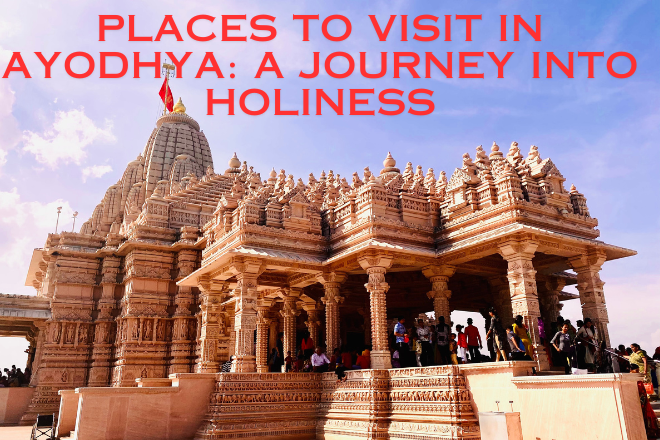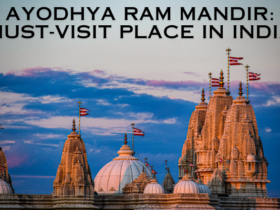Places to visit in Ayodhya: Ram Mandir, also called The Ram Janmabhoomi Mandir. It is a Hindu temple located at Ayodhya, Uttar Pradesh, India. Constructed at the location thought to be the birthplace of the revered Hindu deity Lord Rama.
Hindus attach great cultural and religious significance to the building of the Ayodhya Ram Mandir. Many consider it to be the fulfillment of a long-held aspiration. The process has also triggered discussions on religious harmony and the defense of minority rights in India.

Places to visit in Ayodhya
- Ram Janmabhoomi
- Hanuman Garhi
- Kanak Bhawan
- Treta Ke Thakur
- The Temple of Nageshwarnath
- Swarg Dwar
- Guptar Ghat
1. Ram Janmabhoomi
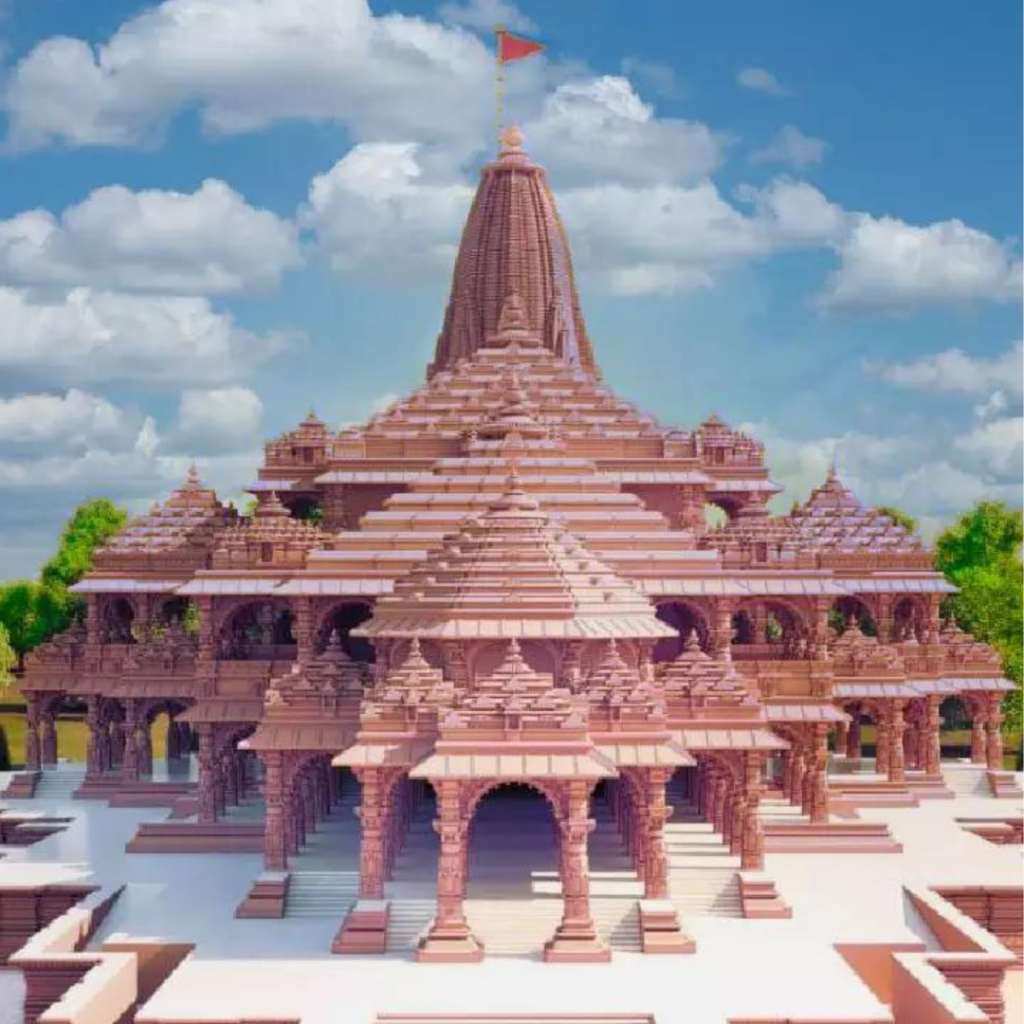
The holy site known as Ram Janmabhoomi is located in Ayodhya, Uttar Pradesh. Many people believe that Lord Rama, a highly revered figure in Hinduism, was born in this place.Translated from Sanskrit, “Janmabhoomi” means “birthplace.”. One of the most important pilgrimage sites in India, this location is extremely important to Hindus, both religiously and culturally.
The construction of the Ram Mandir at Ram Janmabhoomi is hailed as a momentous occasion in Hindu history. For millions of Hindus, who believe Lord Rama was born in Ayodhya, it represents the realization of a lifelong dream. The location now serves as a symbol of both cultural and religious identity, uplifting Hindus’ sense of pride and solidarity.In India, debates about religious harmony, secularism, and the defense of minority rights have centered on the Ram Janmabhoomi issue. The settlement of the Ayodhya dispute and the subsequent building of the Ram Mandir have triggered discussions on the need to draw a fine line between historical justice, community relations, and the ideals of a secular state.
2.Places to visit in Ayodhya- Hanuman Garhi

A well-known temple called Hanuman Garhi is situated in Ayodhya, Uttar Pradesh, India. Perched on a mound, it is extremely sacred to Hindus, especially those who worship Lord Hanuman. The temple honoring Lord Hanuman, a key figure in the Hindu epic Ramayana, is named “Hanuman Garhi,” meaning “Hanuman’s Fort.” The principal deity worshipped at Hanuman Garhi is Lord Hanuman.Devotees pray to the goddess and ask for her blessings for courage, strength, and protection. The idol is frequently decorated with orange sindoor (vermilion). The temple exudes a deeply religious atmosphere, filled with unceasing chants and hymns honoring Lord Hanuman.
Hanuman Garhi is a prime example of Ayodhya’s intercultural harmony. The architecture illustrates the historical convergence of various cultural influences in the area with its synthesis of Hindu and Muslim styles. A trip to Hanuman Garhi essentially entails more than just religious worship; it is an exploration of Ayodhya’s rich cultural and spiritual legacy, providing devotees with an unparalleled fusion of architecture, devotion, and scenic beauty.
3. Places to visit in Ayodhya- Kanak Bhawan

Kanak Bhawan, situated in Ayodhya, Uttar Pradesh, is a well-known Hindu temple with significant religious and historical importance.. Lord Rama and Goddess Sita are the temple’s patron saints. The translation of “Bhawan” as residence and “Kanak” as gold highlights the temple’s wealth and reverence. Kanak Bhawan houses the main gods, Lord Rama and Goddess Sita.The idols have elaborate clothing and jewelry that perfectly adorns them. Devoted individuals go to the temple in hopes of receiving the divine couple’s blessings for marital bliss, wealth, and harmonious families.
Kanak Bhawan, like many other temples in Ayodhya, is a symbol of the harmony between the various cultures in the area. The temple exhibits the diversity and synthesis of Indian cultural traditions through its architecture and rituals, which combine a variety of historical influences. Kanak Bhawan is essentially a holy place where devotees can commune with the divine presence of Lord Rama and Goddess Sita, and it serves as a monument to Queen Kaikeyi’s unwavering love and devotion. Infact, the temple in Ayodhya holds a renowned stature for its architectural splendor, religious rites, and profound historical significance, thus serving as a crucial component of the city’s cultural and spiritual environment.
4. Treta ke thakur
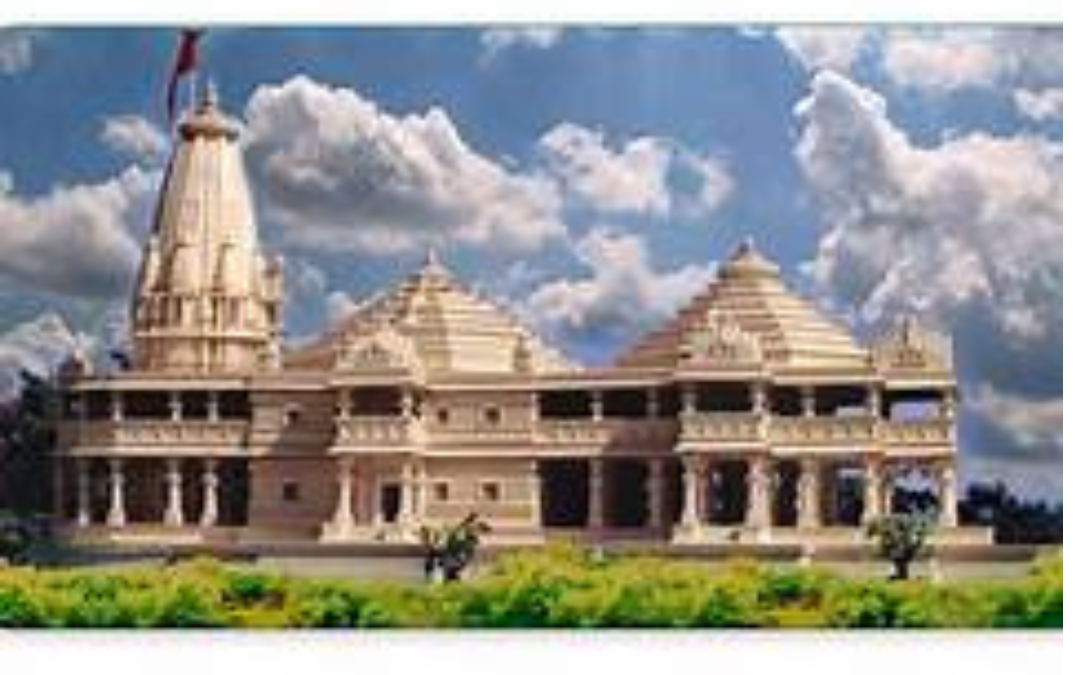
A notable temple, Treta Ke Thakur, is located in Ayodhya, Uttar Pradesh, India.. Its name translates to “Deity of Treta,” alluding to one of Hinduism’s four cosmic ages, the Treta Yuga. Due to the belief that Lord Rama carried out the Ashwamedha Yajna, or horse sacrifice, here during his rule, this temple holds immense religious significance. The central sanctum of Treta Ke Thakur houses the deity associated with Lord Rama’s Ashwamedha Yajna. In order to obtain the deity’s blessings for wealth, morality, and spiritual health, devotees make prayers and carry out rituals.
By conserving the mythological and historical accounts of Lord Rama, the temple adds to Ayodhya’s rich cultural and spiritual legacy. Treta Ke Thakur promotes a sense of religious devotion and cultural continuity by serving as a reminder of the event. Treta Ke Thakur serves as a subdued yet spiritually powerful reminder of Lord Rama’s sovereignty and the religious traditions. Ayodhya’s rich religious heritage, the temple’s architectural simplicity and historical and mythological significance make it an appealing destination.
5. The temple of Nageshwarnath

The ancient Hindu temple of Nageshwarnath Temple, devoted to Lord Shiva, is located in Ayodhya, Uttar Pradesh. The temple in question is among the oldest in Ayodhya, as are the religious and mythological traditions of Hinduism. The people living in Ayodhya have maintained a rich cultural harmony, exemplified by the Nageshwarnath Temple. The historical significance of Ayodhya, where coexistence between Hinduism and other religions has been prevalent for centuries, has greatly influenced its cultural legacy.
The Nageshwarnath Temple exudes a deeply spiritual atmosphere, particularly on auspicious occasions and during festivals honoring Lord Shiva. The sacred atmosphere created through the chanting of prayers, filling of incense in the air, and rhythmic ringing of bells appeals to the spiritual desires of devotees. Nageshwarnath Temple is essentially a living reminder of Ayodhya’s enduring spiritual legacy in addition to being a place of worship. For those looking for a closer connection to the religious and cultural legacy of this holy city. Its timeless allure, mythological foundation, and ongoing religious customs make it a highly regarded location.
6. Swarg Dwar
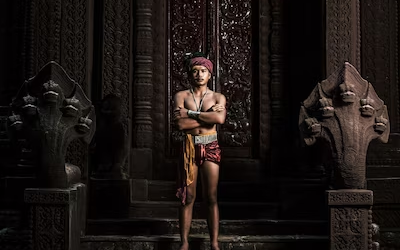
Ayodhya, Uttar Pradesh, India’s Swarg Dwar, which means “Gateway to Heaven,” is a prominent location. The site where Lord Rama left his mortal body to ascend to heaven has great religious significance. It is regarded as a doorway to the divine. At the time of the Ramayana and Hindu mythology both claim that Lord Rama entered the Sarayu River at Swarg Dwar and ascended to the heavenly realm. This event is considered divine, viewed as the pinnacle of Lord Rama’s Earthly avatar.
Swarg Dwar preserves the spiritual story of Lord Rama, adding to Ayodhya’s rich cultural and mythological legacy. In addition to paying respect to the holy person, pilgrims and tourists come to this location to take in the religious and cultural significance ingrained in the history of the city. Swarg Dwar is a symbolic entryway to the divine and a moving reminder of Lord Rama’s celestial journey. In Ayodhya, the site is a place of reflection, spirituality, and cultural heritage because of its serene surroundings and proximity to the holy Sarayu River.
7. Guptar Ghat

Guptar Ghat transcends its physical location next to the river, representing a convergence of spiritual and historical elements. Ghat is thought to be the spot where Lord Rama underwent ‘jal samadhi,’ or submerged himself in the waters. The word “guptar” means hidden.Ayodhya’s pilgrimage circuit includes Guptar Ghat as a mandatory stop. Travelers and pilgrims come to this hallowed location to relive the moment of the divine departure of Lord Rama—the embodiment of dharma—from the serene waters of the Sarayu.
Guptar Ghat preserves the spiritual legacy of Lord Rama, adding to the cultural heritage of Ayodhya. It is evidence of the peaceful coexistence in the area, as individuals from various backgrounds converge to pay their respects to a deity held. Hence, Guptar Ghat serves as more than a mere physical spot on the river. It is a site where spiritual and historical elements converge. Its offering a place for followers to connect with the deep story of Lord Rama’s transcendence.
